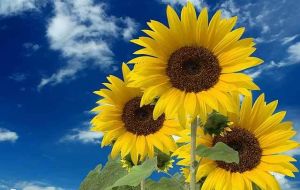MercoPress. South Atlantic News Agency
Argentine Patagonia fossil reveals the origin of sunflower
 Cultivated daisies, chrysanthemums, lettuce, artichokes along with 23,000 other wild species, make up the sunflower family of Asteraceae
Cultivated daisies, chrysanthemums, lettuce, artichokes along with 23,000 other wild species, make up the sunflower family of Asteraceae Sunflowers are likely to have sprung up about 50 million years ago in Argentine Patagonia, suggests a fossil report according to an article in the current edition of Science magazine.
A team led by Argentina's Viviana Barreda of the Museo Argentino de Ciencias Naturales “Bernardino Rivadavia” in Buenos Aires reports the discovery of a fossilized flower from the family home to sunflowers, daisies and dandelions. The fossil turned up in 47.5 million-year-old rock in Argentina's Patagonia region.
The beauty of cultivated daisies, chrysanthemums, and sunflowers, and lettuce and artichokes along with 23,000 other wild species, make up the sunflower family, also known as Compositae or Asteraceae. Today, members of the family are found on every continent except Antarctica, especially in temperate or higher elevation areas in the tropics.
At the time, Patagonia likely enjoyed a balmy and wet climate hospitable to flowers, allowing for the evolution of more varieties.
“At long last, there is clear macrofossil evidence of the sunflower family at an early stage of its diversification, just where it had been hypothesized to originate,” says biologist Tod Stuessy of Austria's University of Vienna, in a commentary accompanying the study.
”Even if researchers accept the sunflower's origin in southern South America, it is still unclear how the family quickly colonized the entire planet and became so incredibly diverse”, he added.
According to the article the Argentine researches theorize that an ancestral reserve of Asteraceae emerged in the Gondwana super-continent before it split up into South America, Africa, India and Australia.
Now the challenge is researching how this family of flowers spread to the globe, since with the exception of Antarctica, the Compositae are present in all continents.




Top Comments
Disclaimer & comment rulesCommenting for this story is now closed.
If you have a Facebook account, become a fan and comment on our Facebook Page!